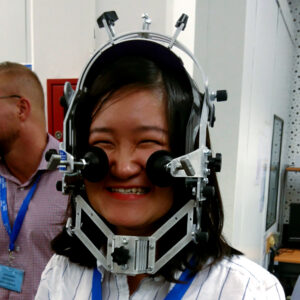Megumi Terada
Humboldt-Universität zu Berlin
Institut für deutsche Sprache und Linguistik
Projects
C06
Seemingly free (morpho)phonetic variation
Contact
Humboldt-Universität zu Berlin, Dorotheenstraße 24, 10117 Berlin

Publications & Presentations
Pescuma, Valentina Nicole; Serova, Dina; Lukassek, Julia; Sauermann, Antje; Schäfer, Roland; Adli, Aria; Bildhauer, Felix; Egg, Markus; Hülk, Kristina; Ito, Aine; Jannedy, Stefanie; Kordoni, Valia; Kühnast, Milena; Kutscher, Silvia; Lange, Robert; Lehmann, Nico; Liu, Mingya; Lütke, Beate; Maquate, Katja; Mooshammer, Christine; Mortezapour, Vahid; Müller, Stefan; Norde, Muriel; Pankratz, Elizabeth; Patarroyo, Angela Giovanna; Plesca, Ana-Maria; Ronderos, Camilo R.; Rotter, Stephanie; Sauerland, Uli; Schulte, Britta; Schüppenhauer, Gediminas; Sell, Bianca Maria; Solt, Stephanie; Terada, Megumi; Tsiapou, Dimitra; Verhoeven, Elisabeth; Weirich, Melanie; Wiese, Heike; Zaruba, Kathy; Zeige, Lars Erik; Lüdeling, Anke; Knoeferle, Pia; Schnelle, Gohar (2023) Situating language register across the ages, languages, modalities, and cultural aspects: Evidence from complementary methods In: Frontiers in Psychology [DOI] [PDF] [ViVo] In the present review paper by members of the collaborative research center ‘Register: Language Users’ Knowledge of SituationalFunctional Variation’ (CRC 1412), we assess the pervasiveness of register phenomena across different time periods, languages, modalities, and cultures. We define ‘register’ as recurring variation in language use depending on the function of language and on the social situation. Informed by rich data, we aim to better understand and model the knowledge involved in situation- and function-based use of language register. In order to achieve this goal, we are using complementary methods and measures. In the review, we start by clarifying the concept of ‘register’, by reviewing the state of the art, and by setting out our methods and modeling goals. Against this background, we discuss three key challenges, two at the methodological level and one at the theoretical level: 1. To better uncover registers in text and spoken corpora, we propose changes to established analytical approaches. 2. To tease apart between-subject variability from the linguistic variability at issue (intra-individual situation based register variability), we use within-subject designs and the modeling of individuals’ social, language, and educational background. 3. We highlight a gap in cognitive modeling, viz. modeling the mental representations of register (processing), and present our first attempts at filling this gap. We argue that the targeted use of multiple complementary methods and measures supports investigating the pervasiveness of register phenomena and yields comprehensive insights into the cross-methodological robustness of register-related language variability. These comprehensive insights in turn provide a solid foundation for associated cognitive modeling.Belz, Malte; Ebert, Melissa; Müller, Miriam; Sun, Jianqi; Terada, Megumi; Xia, Qiang (2023) Einfluss videobasierter Kommunikation (Zoom) auf die Vokalqualität In: P&P 18. Universität Bielefeld [DOI] [ViVo] Phonetik und Phonologie im deutschsprachigen Raum, Phonetik und Phonologie im deutschsprachigen RaumTerada, Megumi; Sell, Bianca Maria; Lange, Robert; Müller, Miriam; Belz, Malte (2023) Documentation and annotation guidelines of CoNNAR Version 1 In: REALIS: Register Aspects of Language in Situation [ViVo] Belz, Malte; Mooshammer, Christine; Sell, Bianca Maria; Terada, Megumi (2023) Acoustic measures of non-native addressee register for mid to high proficient English learners of German In: International Congress of Phonetic Sciences (ICPhS). Prague Congress Center [ViVo] Lüdeling, Anke; Mooshammer, Christine; Lange, Robert; Sell, Bianca Maria; Terada, Megumi (2023) Corpus of Non-Native Addressee Register (CoNNAR). Version 1 [ViVo] Terada, Megumi (2023) Indirect effect of orthographic form on phonetic realisation in L2 German: A Corpus study of inflectional endings in spontaneous speech In: EuroSLA 32. University of Birmingham [ViVo] Belz, Malte; Zöllner, Alina; Terada, Megumi; Lange, Robert; Adam, Lea-Sophie; Sell, Bianca Maria (2021) Dokumentation und Annotationsrichtlinien für das Korpus BeDiaCo [DOI] [ViVo] BeDiaCo contains topic-led and task-led spontaneous dialogues of 36 participants as well as two read word lists per subject. The main corpus BeDiaCom contains 16 subjects not known to each other in a co-present face-to-face situation. The subcorpus BeDiaCov contains 20 subjects known and familiar to each other in a co-present face-to-face situation and, additionally, in a spatially separated videoconference situation. The corpus contains audio and TextGrid files and is annotated by employing a multi-layer architecture. In addition to a diplomatic transliteration and its phonetic segmentation, further annotation levels contain, for example, annotation values for filler particles, intonation phrases, dialogue structure, word types, and the realization of inflection.Terada, Megumi; Belz, Malte; Mooshammer, Christine; Sell, Bianca Maria (2023) Acoustic measures of non-native addressee register for mid to high proficient English learners of German In: International Congress of Phonetic Sciences (ICPhS). Prague Congress Center [ViVo] Belz, Malte; Lüdeling, Anke; Mooshammer, Christine; Sell, Bianca Maria; Terada, Megumi; Lange, Robert (2022) Das Berlin Dialogue Corpus (BeDiaCo) und das Corpus of Non-Native Addressee Register (CoNNAR) – themen- und aufgabenorientierte spontansprachliche Dialoge in direkter und videobasierter Kommunikation In: IDS-Methodenmesse 2022 [PDF] [ViVo]